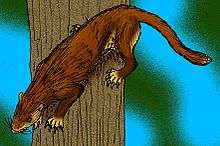Hyopsodontidae
Hyopsodontidae is an extinct family of unspecialized, primitive mammals from the order Condylarthra, living from the Paleocene to the Eocene in North America and Eurasia. Condylarthra is now thought to be a wastebasket taxon; hyopsodontids have occasionally been speculated to be related to Afrotheria,[1] while the most recent consensus appears to be as part of Perissodactyla, and in particular closely related to horses.[2]
| Hyopsodontidae | |
|---|---|
 | |
| Hyopsodus | |
| Scientific classification | |
| Kingdom: | |
| Phylum: | |
| Class: | |
| Order: | |
| Family: | †Hyopsodontidae Trouessart, 1789 |
| Genera | |
|
see text | |
They were generally small insectivorous animals. The most common genus is Hyopsodus.
All of them were small ungulates, their size ranging from that of a squirrel to that of a weasel. Although much more herbivorous in their diet than the arctocyonids, and lacking their powerful canines, the hyopsodontids still had a generalized dentition, with a full set of incisors, canines, premolars, and molars. During the Paleocene in Europe, they reached a high diversity level, starting with Louisina and Monshyus in Hainin, Belgium, and following in the Cernaysian beds with Tricuspiodon, Paratricuspiodon, and Paschatherium.[3]
List of genera
- Aletodon
- Dorraletes[4]
- Haplaletes[5]
- Haplomylus[6]
- Hyopsodus
- Litomylus[7]
- Microhyus
- Paratricuspiodon[8]
- Paschatherium
- Phenacodaptes[9]
- Tricuspiodon[10]
References
- Rodolphe Tabuce et al. (2007) Early Tertiary mammals from North Africa reinforce the molecular Afrotheria clade. Proc. R. Soc. B 2007 274, doi:10.1098/rspb.2006.0229
- Anthony Ravel, Maeva Orliac, The inner ear morphology of the ‘condylarthran’ Hyopsodus lepidus, Historical Biology (Impact Factor: 1.08). 05/2014; 27(8). DOI: 10.1080/08912963.2014.915823
- Agusti, Jordi; Anton, Mauricio (2002). Mammoths, Sabertooths, and Hominids: 65 Million Years of Mammalian Evolution in Europe. Columbia University Press. ISBN 0-231-11640-3..
- Kihm, A.J.; Hartman, J.H. (December 2004). "A reevaluation of the biochronology of the Brisbane and Judson local faunas (late Paleocene) of North Dakota". Bulletin of the Carnegie Museum of Natural History. 2004 (36): 97–107. doi:10.2992/0145-9058(2004)36[97:AROTBO]2.0.CO;2.
- Burger, B.J. (July 2007). "A new Late Paleocene vertebrate fauna from the Ohio Creek Formation of Western Colorado". Mountain Geologist. 44 (3): 141–150. Retrieved 14 August 2020.
- Robinson, P.; Williams, B.A. (May 1997). "Species diversity, tooth size, and shape of Haplomylus (Condylarthra, Hyopsodontidae) from the Powder River basin, northeastern Wyoming". Rocky Mountain Geology. 31 (2): 59–78. Retrieved 14 August 2020.
- Williamson, T.E.; Weil, A. (June 2011). "A New Puercan (Early Paleocene) Hyopsodontid "Condylarth" from New Mexico". Acta Palaeontologica Polonica. 56 (2): 247–255. doi:10.4202/app.2009.0147.
- Rose, K.D.; Storch, G.; Krohmann, K. (November 2013). "Small-mammal postcrania from the middle Paleocene of Walbeck, Germany". Paläontologische Zeitschrift. 89: 95–124. doi:10.1007/s12542-013-0211-3.
- Zack, S.P.; Penkrot, T.A.; et al. (2005). "A new apheliscine "condylarth" mammal from the late Paleocene of Montana and Alberta and the phylogeny of "hyopsodontids"" (PDF). Acta Palaentologica Polonica. 50 (4): 809–830. Retrieved 14 August 2020.
- Thewisson, J.G.M. (1991). "Limb Osteology and function of the primitive Paleocene ungulate Pleuraspidotherium with notes on Tricuspiodon and Dissacus (Mammalia)". Geobios. 24 (4): 483–495. doi:10.1016/S0016-6995(06)80249-4.